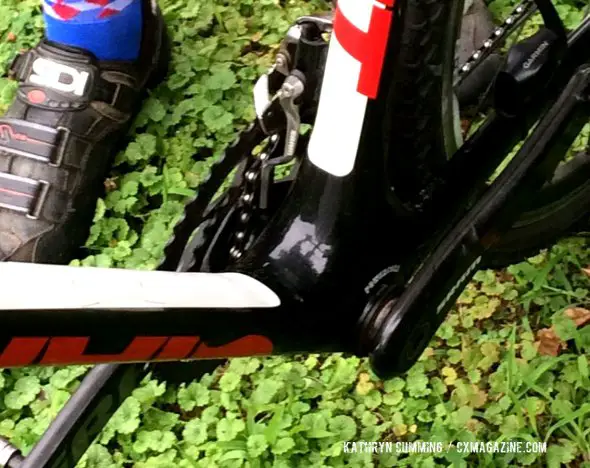The Race Day Situations:
Believe it or not, a dropped chain often comes at the right time in cyclocross (or at least during a manageable time). Usually it happens when you are shouldering your bike among a rowdy group of racers, all climbing over each other up a steep hill, and everyone banging their rear wheels into handlebars. If you hear a familiar sound of a slack chain dangling against your seat stay, don’t panic: there’s a way to get out of this without losing too many places.
The first thing you want to do is get back to level ground; there’s little point in attempting to fixing a chain on a steep run-up. Afterwards, when you are placing your bike back down from your shoulder, be sure to determine which way the chain fell off on so you can adjust your derailleur appropriately. Chains generally fall inward during a run-up, but not always. Just like in practice, run forward to gain speed, and soft-pedal the chain back on the chainring. In theory, since everyone around you is also off their bikes trying to remount after the run-up, the only time you’ll have lost is from the low-torque effort while the everyone else is pounding away. Still, that time lost is much better than all the places you’ll lose when putting the chain back on by hand.
The second most likely place to drop your chain is just after a run-up or barriers, when a rider sets their bike down too harshly or over rough terrain, allowing the chain to bounce off. The solution is exactly the same as before, only a rider is given a much shorter amount of time to react. This is just another reason to properly set your bike down after shouldering!

Properly adjusted chain catchers make this kind of practice difficult, but they also make it harder to drop your chain during an event. © Kathryn Cumming
If you are lucky enough to drop your chain on pavement, there might be no need to get off your bike in the first place. If you are carrying enough speed over the tarmac, use the same method as described above without the dismount/mounting process.
When you must reattach the chain by hand:
Dropping your chain in a few situations can be disastrous. One of the worst would be coming around a corner into a long climb, and hearing your chain dangling against your bottom bracket shell after you tried shifting into your lower gear. You won’t be able to run upwards with a good speed, and attempting to pedal your chain back on during a climb will result in a bad outcome. If the climb is long enough, and riding it will be much faster than running it, you might have to humbly take your bike to the side and get your hands dirty.
In another situation, if you have attempted to pedal the chain back on the chainring, and your pedals keep meeting a spot of huge resistance, you may need to dismount and fix the drivetrain by hand. The only thing worse than losing time to a dropped chain is losing time and money to ripping apart one of your derailleurs.
In last week’s continuing education article we dove into the pros and cons of stepping-thru during the dismount. While that was more of a fun and optional addition to your skills and drills, practicing to prepare for mechanical mishaps is a quick and necessary way for you to salvage future races. A simple 20 minute drill per month should give you the confidence and preparation to handle something as simple as a dropped chain.
Stay tuned to cxmagazine.com for your tips and training needs! Also be on the lookout for a future Mechanical Monday to address measures needed to prevent dropping your chain!
Get schooled in cyclocross with our Cyclocross Academy class list here, and make sure you’re subscribed to Cyclocross Magazine, your guide for getting into the sport, and upping your ’cross knowledge. Not subscribed yet? Our Issue 22 has a story on how to get into racing and what to expect during race day.




























